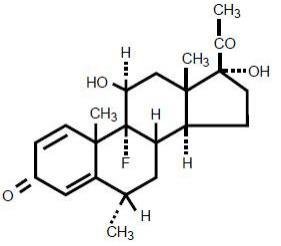Fluorometholone Drops
Dosage form: ophthalmic solution
Drug class:Ophthalmic steroids
Medically reviewed by Drugs.com. Last updated on Sep 1, 2020.
On This Page
Fluorometholone Drops Description
Fluorometholone ophthalmic suspension, USP 0.1% is a sterile topical anti-inflammatory agent for ophthalmic use.
Chemical Name
Fluorometholone: 9-Fluoro-11β,17-dihydroxy-6α-methylpregna-1,4-diene-3,20-dione.
Contains
Active: fluorometholone 0.1%. Preservative:benzalkonium chloride 0.004%. Inactives: edetate disodium; polysorbate 80; polyvinyl alcohol 1.4%; purified water; sodium chloride; sodium phosphate, dibasic; sodium phosphate, monobasic; and sodium hydroxide to adjust pH. Fluorometholone suspension is formulated with a pH from 6.2 to 7.5. It has an osmolality range of 290-350 mOsm/kg.
StructuralFormula

fluorometholone
Fluorometholone Drops - Clinical Pharmacology
Corticosteroids inhibit the inflammatory response to a variety of inciting agents and probably delay or slow healing. They inhibit the edema, fibrin deposition, capillary dilation, leukocyte migration, capillary proliferation, fibroblast proliferation, deposition of collagen, and scar formation associated with inflammation.
There is no generally accepted explanation for the mechanism of action of ocular corticosteroids. However, corticosteroids are thought to act by the induction of phospholipase A2 inhibitory proteins, collectively called lipocortins. It is postulated that these proteins control the biosynthesis of potent mediators of inflammation such as prostaglandins and leukotrienes by inhibiting the release of their common precursor, arachidonic acid. Arachidonic acid is released from membrane phospholipids by phospholipase A2.
Corticosteroids are capable of producing a rise in intraocular pressure. In clinical studies of documented steroid-responders, fluorometholone demonstrated a significantly longer average time to produce a rise in intraocular pressure than dexamethasone phosphate; however, in a small percentage of individuals, a significant rise in intraocular pressure occurred within one week. The ultimate magnitude of the rise was equivalent for both drugs.



